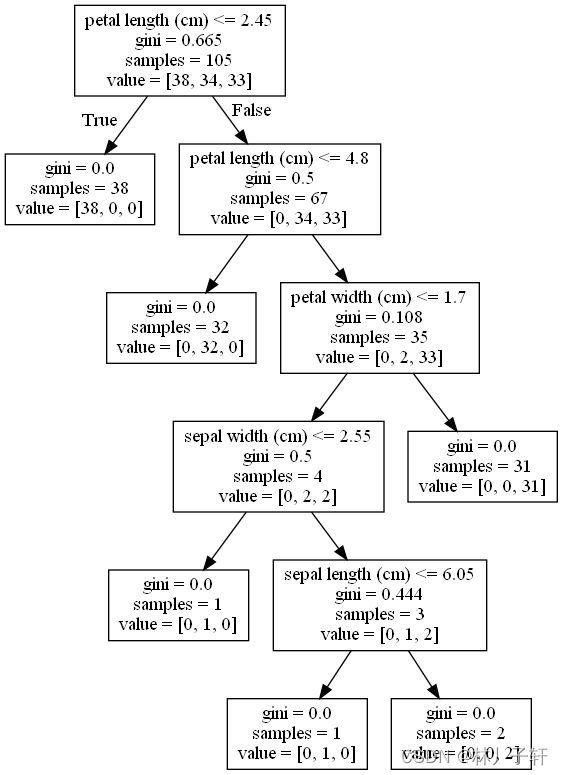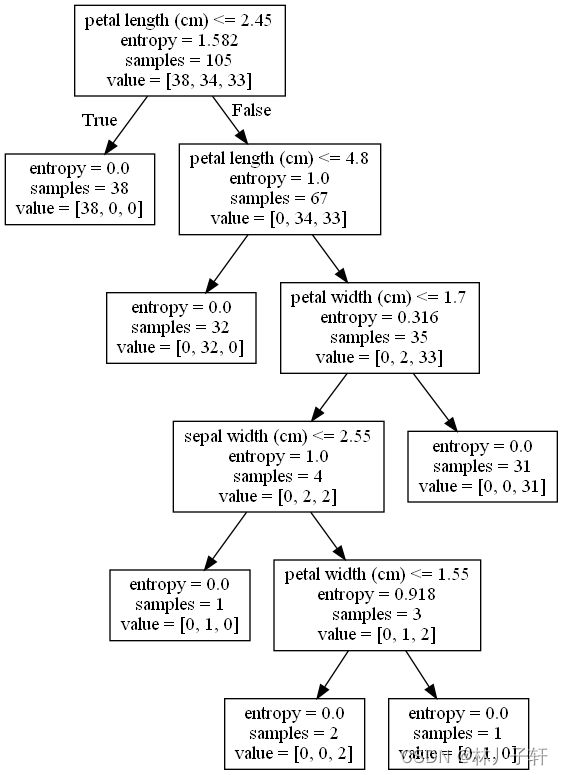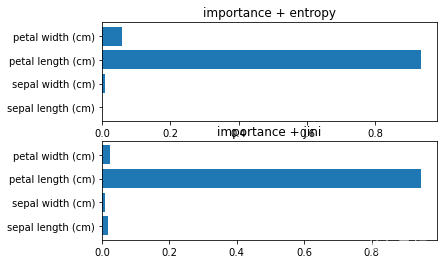决策树初探- 决策树的实现与可视化
之前写过基于逻辑回归的鸢尾花分类,
这一次我们用决策树来试试分类结果
import sklearn.datasets
from pathlib import Path
import subprocess
from sklearn import tree
import numpy as np
import matplotlib.pyplot as plt
from sklearn import metrics
'''加载数据集'''
iris = sklearn.datasets.load_iris()
dir(iris)
['DESCR',
'data',
'feature_names',
'filename',
'frame',
'target',
'target_names']
feature_names = iris.feature_names
#标签有三个['setosa', 'versicolor', 'virginica'] 山鸢尾、变色鸢尾和维吉尼亚鸢尾
'''初始化数据'''
Data ,target = iris.data,iris.target
xTrain,xTest,yTrain,yTest = sklearn.model_selection.train_test_split(Data,target,test_size=0.3,random_state=7)
critertion = ‘entropy’ 采用信息增益的方法,优化决策树
默认’gini
在信息增益中,衡量标准是看特征能够为分类系统带来多少信息,带来的信息越多,该特征越重要。对一个特征而言,系统有它和没它时信息量将发生变化,而前后信息量的差值就是这个特征给系统带来的信息量
'''初始化树'''
dtree1 = tree.DecisionTreeClassifier(criterion='entropy')
dtree2 = tree.DecisionTreeClassifier(criterion='gini')
#
dtree1.fit(xTrain,yTrain), dtree2.fit(xTrain,yTrain)
'''预测标注'''
pre_y1 = dtree1.predict(xTest)
pre_y2 = dtree2.predict(xTest)
light1 = (pre_y1 == yTest)+0
light2 = (pre_y2 == yTest)+0
plt.subplot(121)
plt.scatter(range(len(pre_y1)),pre_y1,c= light1)
plt.title('decision tree + entropy')
plt.xlabel('number of samples ')
plt.ylabel('category')
plt.text(0,1.75,f'score = {metrics.accuracy_score(pre_y1,yTest):.2f}')
plt.subplot(122)
plt.scatter(range(len(pre_y2)),pre_y2,c= light2)
plt.title('decision tree + gini')
plt.xlabel('number of samples ')
plt.ylabel('category')
plt.text(0,1.75,f'score = {metrics.accuracy_score(pre_y2,yTest):.2f}')
plt.show()
Popen原型:
subprocess.Popen(args, bufsize=0, executable=None, stdin=None, stdout=None, stderr=None, preexec_fn=None, close_fds=False, shell=false)
参数bufsize:指定缓冲.
参数executable:用于指定可执行程序。一般情况下我们通过args参数来设置所要运行的程序。如果将参数shell设为 True,executable将指定程序使用的shell
参数stdin, stdout, stderr分别表示程序的标准输入、输出、错误句柄。他们可以是PIPE,文件描述符或文件对象,也可以设置为None,表示从父进程继承
参数stdin, stdout, stderr分别表示程序的标准输入、输出、错误句柄。他们可以是PIPE,文件描述符或文件对象,也可以设置为None,表示从父进程继承
'''显示生成的决策树'''
def check_valid_path(path):
"""检查文件路径是否有效,并返回以'/'分割的文件路径"""
if '\\' in path:
elements = str(Path(path)).split(sep='\\')
final_path = Path('/'.join(elements))
elif '/' in path:
final_path = Path(path)
else:
if not Path(path).exists():
raise Exception("Error: File path pattern is not correct.")
else:
final_path = Path(path)
if not final_path.exists():
raise Exception("Error: Your file path does not exist.")
if final_path != '':
return final_path
else:
return None
def dot2png(dot_file_path=None, img_path=None):
"""决策树可视化中.dot文件转化为.png图片的函数"""
if not dot_file_path:
raise Exception(".dot file is not given.")
elif not dot_file_path.endswith('.dot'):
raise Exception("file provided is not '.dot' type.")
dot_file_path = check_valid_path(dot_file_path)
if not img_path:
img_path = 'Dot/dt_png.png'
elif not img_path.endswith('.png'):
raise Exception("image file not end with '.png'.")
img_path = img_path
cmd_args = 'dot'+'-Tpng'+dot_file_path+'-o'+img_path
cmd_pro = subprocess.Popen(args=cmd_args, stdout=subprocess.PIPE, stderr=subprocess.STDOUT)
retval = cmd_pro.stdout.read().decode('gbk')
if retval == '':
print("successfully create file " + img_path)
else:
print("The program encountered some error: ")
print(retval)
# '''方法1,先生成dot文件,然后在cmd命令行中,
# 先到文件所在目录,再运行dot -Tpng dtree.dot -o dtree.png,得到图片'''
with open('Dot/dtree1.dot','w') as f:
tree.export_graphviz(dtree1,f,feature_names = feature_names)
with open('Dot/dtree2.dot','w') as f:
tree.export_graphviz(dtree2,f,feature_names = feature_names)
# '''方法2,可能有bug,未实际使用,只提供思路'''
# file_dot = "Dot/dtree.dot"
# out_png = "Dot/dtree.png"
# cmd_args = f"dot - Tpng {file_dot} -o {out_png}"
# subprocess.Popen(args = "D:")
# cmd_pro = subprocess.Popen(args=cmd_args, stdout=subprocess.PIPE, stderr=subprocess.STDOUT)
#
# '''方法三,调用封装函数'''
以上是基于信息增益所生成的决策树模型
以下是基于Gini系数生成的决策树模型

评估特征的重要性,也就是查看是那个特征最大限度上决定了分类
plt 画柱状图
纵向柱状图bar
plt.bar(x, height, width=0.8, bottom=None, *, align=‘center’, data=None, **kwargs)
横向柱状图barh,简单理解bar旋转90°
plt.barh(y, width, height=0.8, left=None, *, align=‘center’, **kwargs)
plt.bar()
x:表示x坐标,数据类型为int或float类型,刻度自适应调整;也可传dataframe的object,x轴上等间距排列;
height:表示柱状图的高度,也就是y坐标值,数据类型为int或float类型;
width:表示柱状图的宽度,取值在0~1之间,默认为0.8;
bottom:柱状图的起始位置,也就是y轴的起始坐标;
align:柱状图的中心位置,默认"center"居中,可设置为"lege"边缘;
color:柱状图颜色;
edgecolor:边框颜色;
linewidth:边框宽度;
tick_label:下标标签;
log:柱状图y周使用科学计算方法,bool类型;
orientation:柱状图是竖直还是水平,竖直:“vertical”,水平条:“horizontal”;
dtree1_importance = dtree1.feature_importances_
dtree2_importance = dtree2.feature_importances_
# 这是一个归一化的矩阵
plt.subplot(211)
plt.barh(range(4),dtree1_importance,align='center',tick_label =feature_names)
plt.title('importance + entropy')
plt.subplot(212)
plt.barh(range(4),dtree2_importance,align='center',tick_label =feature_names)
plt.title('importance + jini')
plt.show()
由上图可见,对于鸢尾花的分类,决策树主要依据 petal width 和petal length 特征来进行不同类别的区分
这个结果我们也可以在生成的dtree图中发现,depth = 0 的判断条件为petal with <= 0.8 就将45 个山鸢尾 全部分类完毕
推荐文章
Sober算子边缘检测与Harris角点检测1
主成分分析,独立成分分析,+t-SNE 分布随机可视化降维的对比
线性回归预测波士顿房价
基于逻辑回归的鸢尾花分类
参考文献
机器学习 使用OpenCV、Python和scikit-learn进行智能图像处理(原书第2版)-(elib.cc) by (印)阿迪蒂亚·夏尔马(Aditya Sharma)(印)维什韦什·拉维·什里马利(Vishwesh Ravi Shrimali)(美)迈克尔·贝耶勒(Michael Beyeler)
信息增益
决策树dot文件转为png格式


